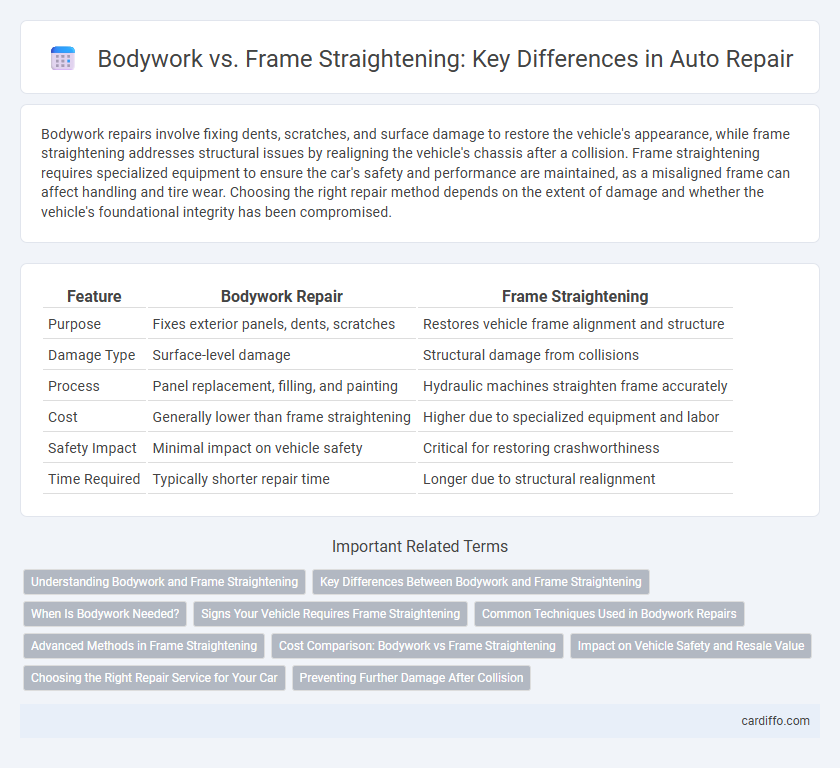Bodywork repairs involve fixing dents, scratches, and surface damage to restore the vehicle's appearance, while frame straightening addresses structural issues by realigning the vehicle's chassis after a collision. Frame straightening requires specialized equipment to ensure the car's safety and performance are maintained, as a misaligned frame can affect handling and tire wear. Choosing the right repair method depends on the extent of damage and whether the vehicle's foundational integrity has been compromised.
Table of Comparison
| Feature | Bodywork Repair | Frame Straightening |
|---|---|---|
| Purpose | Fixes exterior panels, dents, scratches | Restores vehicle frame alignment and structure |
| Damage Type | Surface-level damage | Structural damage from collisions |
| Process | Panel replacement, filling, and painting | Hydraulic machines straighten frame accurately |
| Cost | Generally lower than frame straightening | Higher due to specialized equipment and labor |
| Safety Impact | Minimal impact on vehicle safety | Critical for restoring crashworthiness |
| Time Required | Typically shorter repair time | Longer due to structural realignment |
Understanding Bodywork and Frame Straightening
Bodywork involves repairing or replacing the outer panels of a vehicle to restore its appearance after minor to moderate damage, such as dents, scratches, or rust. Frame straightening is a specialized process that uses hydraulic machinery to realign the vehicle's structural frame, correcting bends or distortions caused by severe collisions. Understanding the distinction between bodywork and frame straightening is crucial for ensuring proper vehicle safety and aesthetic restoration.
Key Differences Between Bodywork and Frame Straightening
Bodywork involves repairing or replacing damaged vehicle panels like doors, fenders, and bumpers to restore the exterior appearance, while frame straightening focuses on correcting the vehicle's structural chassis after a collision for proper alignment and safety. Bodywork primarily addresses cosmetic and minor structural issues, whereas frame straightening ensures the frame's integrity and drivability by using specialized equipment to realign bent or twisted frames. Accurate frame straightening is critical for vehicle safety and performance, whereas bodywork is essential for aesthetic restoration and corrosion prevention.
When Is Bodywork Needed?
Bodywork is needed when visible dents, scratches, rust, or minor structural damage affect the vehicle's exterior panels and paint, compromising aesthetic appeal and surface integrity. It addresses issues like chipped paint, small dents, and panel alignment without altering the vehicle's main structural frame. Frame straightening is not required unless the car has sustained significant impact that has bent or twisted the underlying chassis.
Signs Your Vehicle Requires Frame Straightening
Visible misalignment of doors, trunk, or hood often signals the need for frame straightening as it indicates structural damage beyond surface bodywork. Uneven tire wear and steering that pulls to one side suggest the vehicle's frame has been compromised, requiring precise frame alignment. Cracks in the chassis or a vehicle that feels unstable during driving are clear indicators that professional frame straightening is essential for safety and performance restoration.
Common Techniques Used in Bodywork Repairs
Common techniques used in bodywork repairs include panel beating, dent pulling, and paintless dent removal, which restore the vehicle's surface without altering its structural integrity. Bodywork focuses on reshaping and refinishing exterior panels using tools such as hammers, dollies, and suction devices to eliminate imperfections. This approach contrasts with frame straightening that realigns the vehicle's chassis using specialized machines and hydraulic presses to correct underlying structural damage.
Advanced Methods in Frame Straightening
Advanced methods in frame straightening utilize precise computerized measuring systems and hydraulic machines to restore vehicle frames to factory specifications, ensuring structural integrity and safety. Techniques such as laser-guided frame alignment and computerized 3D measuring systems allow technicians to detect and correct even the smallest distortions in the chassis. These innovations improve accuracy compared to traditional bodywork, significantly enhancing the repair quality for modern vehicles.
Cost Comparison: Bodywork vs Frame Straightening
Bodywork repairs typically cost between $500 and $2,000, depending on the extent of cosmetic damage, while frame straightening ranges from $600 to $1,500, focusing on structural alignment. The final price for bodywork varies with paint jobs and dent removal complexity, whereas frame straightening prices depend on the severity of chassis bending and necessary precision equipment. Choosing between bodywork and frame straightening hinges on damage type, as bodywork addresses surface issues and frame straightening restores vehicle safety and driveability.
Impact on Vehicle Safety and Resale Value
Bodywork repairs restore a vehicle's exterior appearance but may not address structural damage, potentially compromising safety and reducing resale value if underlying issues persist. Frame straightening realigns the vehicle's chassis to factory specifications, ensuring optimal structural integrity for crash protection and preserving resale value. Choosing frame straightening over surface-level bodywork significantly impacts long-term vehicle safety and market worth.
Choosing the Right Repair Service for Your Car
Selecting the appropriate repair service depends on accurately identifying damage type: bodywork addresses surface dents, scratches, and panel replacement, while frame straightening corrects structural misalignment caused by collisions. Prioritize a repair shop with certified technicians equipped with advanced frame measuring systems if structural integrity is compromised. Ensuring precise diagnosis and specialized expertise prevents future safety hazards and maintains vehicle value post-repair.
Preventing Further Damage After Collision
Bodywork repairs address visible dents and scratches on the vehicle's exterior, restoring the surface to its original condition and preventing rust or corrosion. Frame straightening corrects the vehicle's structural alignment using specialized equipment, ensuring the chassis maintains its integrity and prevents misalignment-related issues that can worsen over time. Opting for frame straightening after a collision is crucial to avoid compromised handling, uneven tire wear, and potential safety hazards resulting from an improperly aligned frame.
Bodywork vs Frame Straightening Infographic

 cardiffo.com
cardiffo.com